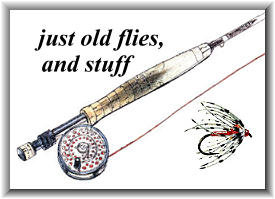Charles F. Orvis created this fly and Albert N. Cheney
named it after Fred Mather, foremost angling authority
of his time. Mr. Mather was born in New York State in
1833 and died in Wisconsin in 1900. He was a close
associate and friend of Seth Green.
Shortly after the United States Fish Commission was
formed, he became the assistant commissioner. He did
considerable experimental work in the artifical hatching
of graying at the Cold spring Harbor Hatchery, where he
develiped and patented the "Mather Hatching Cone."
He was the American representative to the Internation
Fisheries Exhibition in Berlin, Germany, in 1880. From
1883 to 1895 he was a Commissioner of the State of New
York Fish Commission. He was for a long time fishing
editor of Forest and Stream. Many of his articles
appeared in the American Angler.
It was Mr. Mather who prepared the rules for the fly-casting
tournament that was held at Brighton Beach, Coney Island, in
June of 1881, at which tournament the Nation Rod & Reel
Association was formed. Mr. Mather also acted as the judge
in that contect. He was secretary of the National Rod &
Reel Association from 1882 to 1886.
Two of his books that should be in every angling library are Men
I Have Fished With and My Angling Friends.
He also wrote Modern Fish Culture in Fresh and Salt Water,
1905.
The fly, as tied by Mr. Orvis, was described as having a dark
greenish black herl body, with a green silk wound mid-section,
large gray wings and gray hackle; red and gold tag; and a long
waving, green tail.
The dressing given in Forgotten Flies is:
Tag: Gold tinsel and scarlet floss.
Tail: Peacock sword.
Body: Black ostrich herl, pale green floss,
black ostrich herl.
Wing: Gray goose breast.
Hackle: Gray.
Credits: Text from Fly Patterns and Their Origins,
By Harold Hinsdill Smedley. Color photo and second recipe from
Forgotten Flies published by Complete
Sportsman.
|



